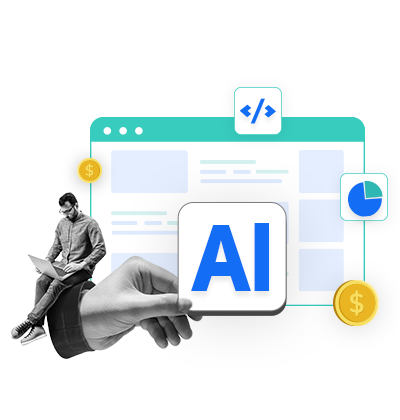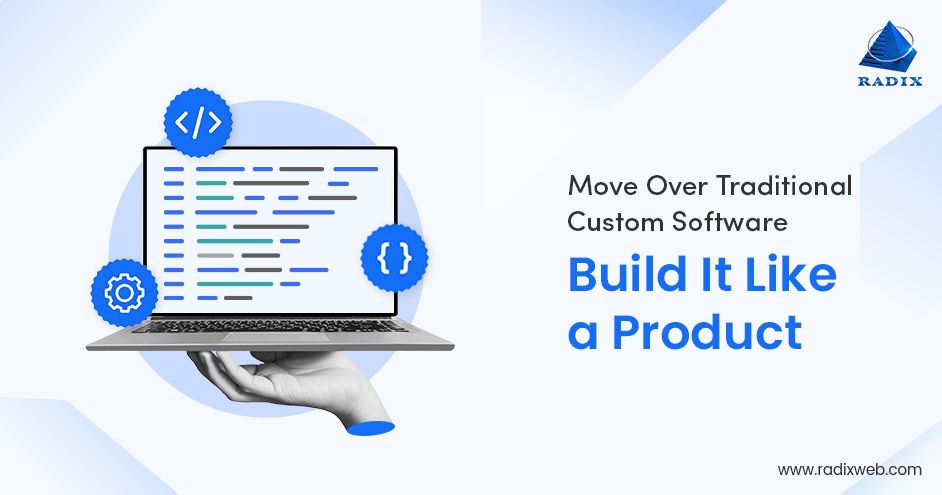Read More

Skip Setup Headaches and Start Your Project Fast - Download Free Boilerplates
ON THIS PAGE
Quick Summary: Many AI initiatives show early promise but fail to deliver long-term value. This blog explores why scaling AI is challenging. It also shares practical guidance on building custom AI software that is secure, scalable, and designed to generate measurable ROI for enterprises over time.
AI is driving some of the biggest efficiency gains businesses have ever seen by automating tasks and providing better insights. Companies that use it well reduce workflow friction, make smarter decisions, and can see measurable ROI. That’s why more leaders are turning to custom software development for streamlining operations and cutting costs. The challenge? Most fail to make AI work when it scales.
According to a report by McKinsey, nearly 80% of enterprises experiment with AI. The problem behind this number is not the technology used; it’s the approach. When you begin development without a clear goal, generating an ROI for the long-term becomes impossible.
To succeed, you need to focus on building AI that can scale, is secure, and can be improved based on the feedback loop. That’s how a prototype can be transformed into a production-grade AI which can actually help solve real-world problems.
If you want to learn what considerations to make when developing custom AI, this blog is for you. We’ll cover everything from why most AI projects fail at scaling to steps you can follow to build an enterprise-ready AI solution. With that said, let’s begin with why exactly you need a custom AI.
What is the Need for Custom AI Software Development?
There are many off-the-shelf software solutions that may work for common problems. But when it comes to getting a solution for a specific and unique problem that you face, building a custom AI can be the smart choice. Here are the reasons many companies opt for it.
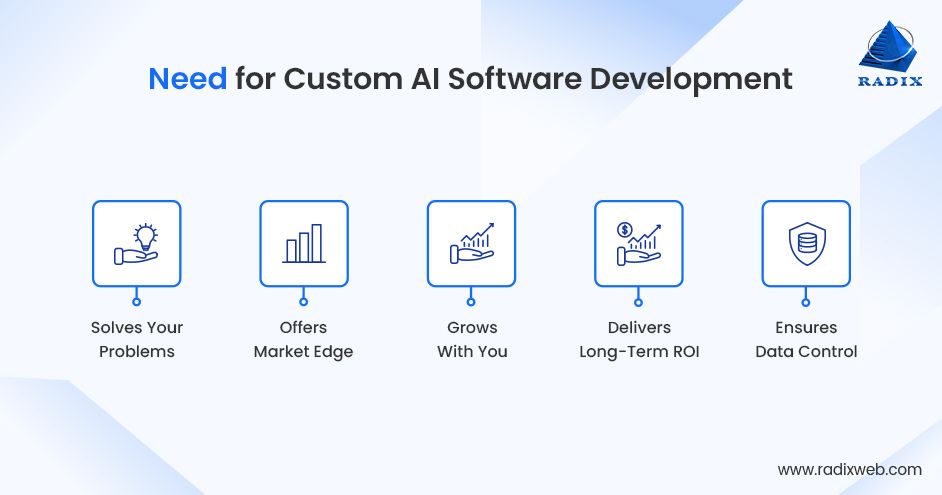
Solves Your Specific Problems
Most pre-built AI tools are designed for mass appeal. But your challenges? They’re unique. Custom AI solutions are built around your workflows, data, and goals. That means the tech adjusts to your business and not the other way around.
Gives You a Competitive Edge
Custom AI becomes your intellectual property. It's not something your competitors can buy or replicate. This gives you a long-term advantage. The software product can be a smart automation tool or an extension that simplifies web security; it’s yours. And it grows with your business.
Scales With You
Generic AI can hit limits as you grow. Custom AI is built with scalability in mind. You can add new features, support more users, or integrate into new systems as your needs evolve. It reduces future tech debt and keeps things running smoothly even when your business scales.
Delivers Long-Term ROI
You’re not paying for features you don’t need. Every dollar goes toward solving your specific problem. That’s why custom AI often pays off faster than expected. It may have a high up-front cost, but in the long run, custom AI software makes a real difference in your bills, saving you thousands, if not more.
Keeps Your Data Safe and in Control
When you use ready-made tools, your data might sit on third-party servers or be processed by black-box algorithms. With custom AI, you choose where and how your data is handled. That’s critical for compliance, trust, and long-term risk management. You stay in control, always.
Why Do Most Custom AI Projects Fail to Scale?
“The biggest challenge in AI isn’t the algorithm — it’s making it work at scale.” — Fei-Fei Li, Stanford Professor and AI Pioneer.
Building a custom AI prototype can be simple when compared to a real-world project. Although the prototype and production software output the same thing, they need to be built differently. A prototype can barely handle 100 users, while a production-level AI software needs to handle at least 10,000 or more users.
And the truth is, many AI projects fail when they try to move beyond the prototype. Here are the reasons why it happens:
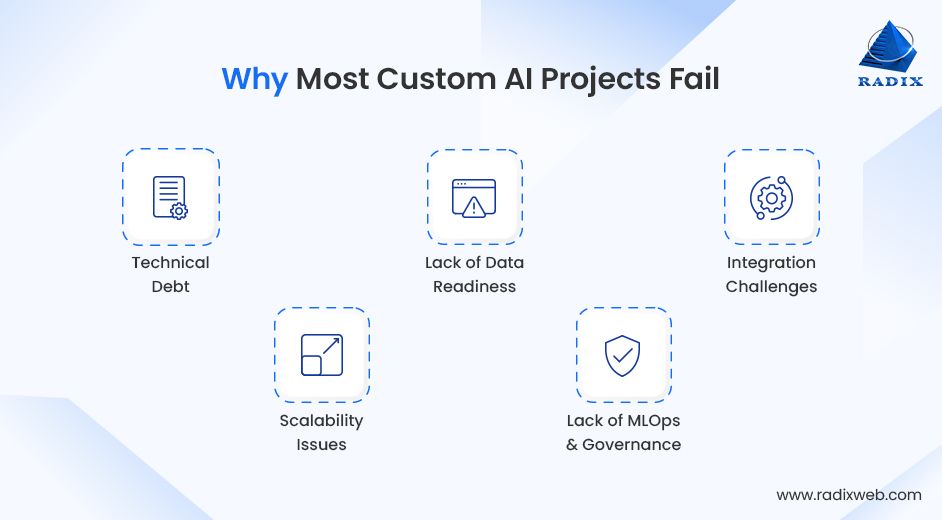
Technical Debt
When teams rush to prove a concept, they often don’t consider it on a higher scale. The prototype works, but the code isn’t built for handling millions of requests. This creates technical debt, which leads to more code refactoring and hidden bugs. Over time, this slows development and makes scaling almost impossible. That’s why most leaders focus on reducing technical debt by prioritizing the importance of stability over quick solutions.
Data Readiness
Proof-of-concept (POC) AI models usually run on clean, well-structured data. But in reality, most data are messy, inconsistent, and full of gaps. When the AI hits real-world data, accuracy falls. Many projects fail because they underestimate how much effort data cleaning and preprocessing require on a larger scale.
Integration Challenges
Your AI solution needs to plug into existing systems like ERPs, CRMs, and other tools. These integrations are rarely simple. Mismatched data formats, slow APIs, or outdated infrastructure slow down your project. And without seamless integration, scaling comes to a halt.
Scalability Issues
What works for a small group often breaks when the number of users increases. AI models can slow down or fail under heavy loads. The infrastructure may not support rapid scaling. Planning for peak loads and flexible resource allocation is needed, and many projects miss that step.
Lack of MLOps & Governance
AI is not “set and forget.” Models degrade over time and need to be retrained with fresh data. Without MLOps, the practices and tools to manage AI lifecycle fail. Monitoring, version control, compliance checks, and governance are required to keep AI effective and trustworthy.
Key Considerations of Building Custom AI Software for Long-Term ROI
When building a custom AI for the long-term, you need to plan for scalability, security, and of course, the cost. Here are the important considerations that will help you build an AI software that lasts.
Start with a Clear Business Goal
Before anything else, know what you want AI to do for your business. It’s easy to chase AI trends, but without a clear goal, you risk building something that doesn’t solve real problems. Defining specific outcomes helps keep your project focused and measurable. This way, you’re investing in solutions that truly matter to your company’s growth.
Design for Scalability
AI that works for 100 users might crash when you hit 10,000. Planning scalability upfront means thinking about future users, more data, and new features from day one. It saves you costly rewrites and frustration down the line. Good design and architecture keep your AI ready to grow with no surprises or limits.
Prioritize Integration with Existing Systems
Your AI won’t operate in isolation. It has to work with ERPs, CRMs, and legacy tools already in place. If it doesn’t fit smoothly, the whole process breaks down. Prioritizing integration means faster automation and a better experience. AI should make workflows easier, not more complicated.
Plan for Security and Compliance
Data breaches and compliance failures can cost millions, along with your brand reputation. From the start, build your AI with security protocols and regulatory requirements in mind. You must follow compliance such as HIPAA, GDPR, and SOC2 because strong security is non-negotiable for long-term success.
Focus on User Experience
Even the smartest AI fails if it has a bad user experience. A simple and quick interface that fits naturally into existing workflows allows people to navigate easily. Training and change management go together. When people find the AI easy and helpful, ROI follows organically.
Consider Total Cost of Ownership (TCO)
Custom AI isn’t just a one-time purchase. You need to budget for infrastructure, updates, maintenance, and training over the years. Ignoring these ongoing costs can turn a promising project into a financial drain. Real ROI comes from understanding and planning for the full lifecycle expenses.
Ongoing Maintenance and Continuous Improvement
AI models get outdated if there are no constant updates in algorithms or if no new data is provided. They need regular retraining, monitoring, and tweaks as your business and data evolve. Treat AI as a living system, not a finished product. Continuous improvement ensures your investment keeps paying off and adapts to changing needs.
Steps for Developing a Prototype to Production-Grade AI
Moving AI software from prototypes to scalable systems is not simple if you don't follow the right steps. With a clear blueprint, you can make sure the AI software build happens in a scalable way.
Below are the key steps that help bridge the gap between experimentation and long-term impact.
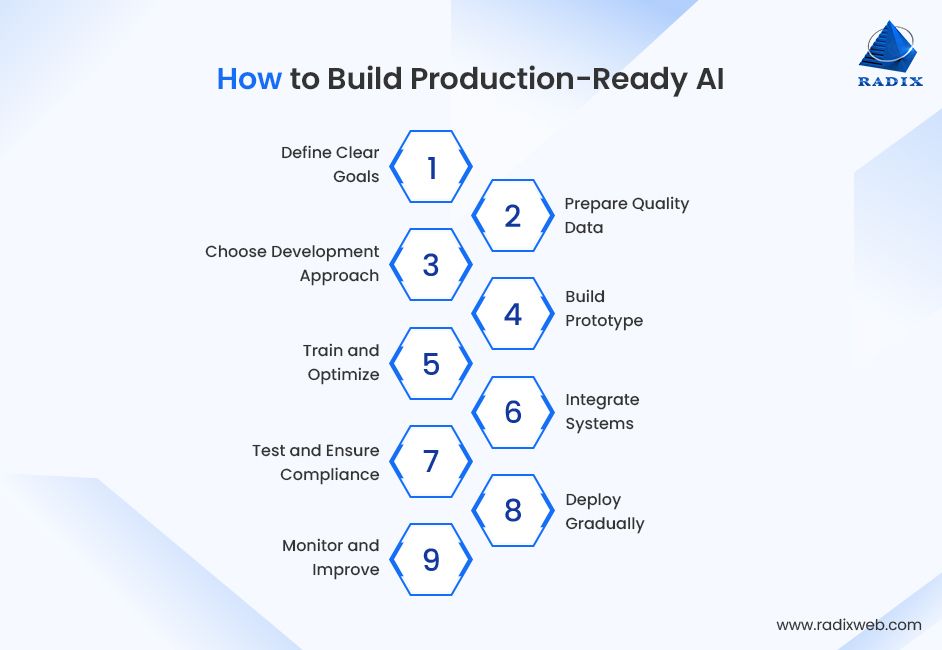
1. Define Clear Goals and Use Cases
Before any code is written, clarity is essential. Ask: What problem are we solving, and why does it matter to the business? A well-defined goal prevents teams from building prototypes that never deliver value.
For example, if your company wants to cut customer service costs, the goal could be: Reduce average handling time by 20% using an AI-powered assistant. That’s measurable and can directly impact the ROI.
Also, keep the use case specific. Broad goals like “AI for customer service” often fail. Narrow down to something specific, such as automating password resets or addressing support tickets. If you start with clarity, there are chances you will build an AI solution that actually helps.
2. Collect and Prepare High-Quality Data
AI is only as good as the data behind it. Many prototypes run on small, clean samples. But production systems face messy, incomplete, and ever-changing data. Leaders need to invest early in data readiness.
The collected data must be accurate, relevant, and secure. Standardize data formats, remove duplicates, and set up pipelines that ensure new data gets updated. Think of it as laying the foundation for a building; you can’t scale on shaky ground.
For financial leaders like CFOs, data quality is directly tied to cost and compliance. Poor data means wasted computing cycles, incorrect outputs, and higher risks. For IT leaders, building processes for governance and monitoring data streams ensures stability when scaling.
3. Select the Right Development Approach
Not every AI project should be built from scratch. The right software development approach depends on your goals, resources, and timeline.
- Custom development: Best if your use case is unique or requires deep integration. This gives control but takes longer and costs more.
- Pre-built models or APIs: Ideal for quick wins or when solving common problems like text classification or translation. Faster, but less flexible.
- Hybrid approach: Start with pre-trained models, then customize or extend it with new features as the use case matures.
Decision-makers should weigh not just upfront costs, but long-term ROI. A cheap shortcut today can become expensive to maintain tomorrow.
4. Build a Functional AI Prototype
This is where ideas start to take shape. A prototype should prove that the concept works, not solve every challenge at once. Keep it simple and focused, and built to answer one question: Does this approach solve the problem we defined earlier?
For leaders, the goal isn’t a finished product yet. It’s to validate assumptions with minimal time and resources. A simple chatbot that handles one type of request is enough to show potential. A forecasting model that predicts demand for one product line can confirm its feasibility.
The biggest mistake at this stage is overdoing features. Don’t invest in heavy infrastructure or features you don’t need yet. The prototype is about solving the problem and securing buy-in from stakeholders. Once it proves its value, you’ll have the evidence to justify scaling.
5. Train, Optimize, and Prepare for Scaling
After the prototype shows promise, the focus shifts to performance. This is where you move beyond small test sets and run the model with real-world data.
Training should include larger, more representative data. But just throwing in more data isn’t enough. Models must be optimized for speed, accuracy, and efficiency. The teams should track business-focused metrics like response time, cost per prediction, or error rates tied to customer impact.
At this stage, it’s also smart to think ahead. Will the model hold up if usage grows tenfold? Will costs remain manageable? Preparing for scale means building monitoring tools and planning retraining cycles. The earlier you think about these, the smoother the transition to production-grade AI will be.
6. Integrate with Existing Tools and Systems
For AI to create real business value, it must work seamlessly with the systems your teams already rely on.
This means connecting your AI with CRMs, ERPs, cloud platforms, or analytics dashboards. For IT leaders, integration ensures workflows stay efficient. For finance leaders, AI insights are fed directly into planning and reporting. For operations, it means no disruption in the daily workflow.
Integration is often where prototypes succeed or fail. A model that works in a lab but can’t plug into enterprise tools might not get adopted that easily. Involve your system architects early, test compatibility, and focus on APIs and middleware that make integration smoother. This step is as much about change management as it is about technology.
7. Test, Validate, and Ensure Compliance
Before an AI system goes live, it must be tested in conditions that mirror the real world. That means checking not just accuracy, but also reliability, security, and compliance. For technology leaders, it’s about trust. For finance and risk leaders, it’s about protecting the business from unnecessary exposure.
Testing should include scaled scenarios: What happens when traffic spikes occur? Can the system handle poor-quality data? Validation must go beyond technical metrics and include business KPIs, such as reduced processing time or improved decision accuracy.
And compliance is equally critical. Whether it’s GDPR, HIPAA, or internal data policies, every deployment must meet regulatory requirements. Skipping this step can expose the company to fines and reputational damage. Early involvement of legal, compliance, and security teams avoids costly rework later.
8. Deploy the Custom AI Solution
Deployment is the point where prototypes become genuine business assets. But it’s not about flipping a switch. Smart deployment is gradual and controlled.
Start small, perhaps with one business unit or a limited set of users. Monitor results closely, gather feedback, and refine them before scaling across the enterprise. This reduces risk and builds confidence among stakeholders.
Deployment also needs alignment with IT and operations teams. Proper infrastructure, clear documentation, and training help the end users to adopt. For CFOs, staged rollouts help track costs and demonstrate ROI step by step.
9. Continuously Monitor and Improve with Feedback Loops
AI is never “done.” Models degrade over time as data, users, and business needs change. Continuous monitoring ensures the system stays accurate, efficient, and valuable.
Set up dashboards to track key metrics: performance, usage, costs, and business outcomes. Build feedback loops where users can flag issues or suggest improvements. This keeps the system aligned with real-world needs.
Improvement may mean retraining models, updating data pipelines, or refining integrations. The goal is to make AI the support system, not a one-time project. Leaders who treat AI as an evolving asset see stronger ROI and less disruption over the long term.
How Radixweb Ensures Your Custom AI Software Delivers for Long-Term ROI
Choosing the right partner for AI development can make the difference between a project that only stays at the prototype stage and one that scales. At Radixweb, with 25+ years of experience, we’ve helped enterprise leaders build scalable AI solutions from healthcare software to the retail & eCommerce industry. Here’s why organizations trust us with their AI journey.
- Radixweb works with you from the strategy phase, through prototyping, to scaling in production, and then managing the system over time. This reduces the common drop-offs we see when companies try to move from “proof of concept” to business-wide adoption.
- We validate use cases early, run lean pilots, and use step-by-step rollouts that allow teams to adopt AI without disruption. That means fewer errors, clearer ROI tracking, and smoother enterprise integration.
- Our teams combine expertise in software engineering, data science, and machine learning. This balance ensures we’re not just experimenting with algorithms but building secure and production-grade systems.
- At Radixweb, we have expert software developers working with US-based enterprises, which means we design solutions aligned with local compliance standards and industry regulations. Beyond compliance, we also understand the cultural and operational realities of US businesses.
Here’s one of our clients' stories that shows how we delivered a scalable software solution.
Michael, CEO of an environmental software startup (Texas), shares how Radixweb transformed its complex environmental software requirements into a simple execution.
They needed a smart system to monitor emissions from industrial facilities, an AI-like solution that pulls live data from control systems, applies complex calculations, and produces meaningful insights.
Being able to trust a remote partner was key. Michael recalls: “When you work with a company on the other side of the globe, you have to find someone who is trustworthy; Radixweb is.”
They weren’t looking for a copy of other products. Their needs were specific, technical, and high stakes. Radixweb deeply understood the problem, asked smart questions, and built exactly what was needed. The result was a clean, accurate, and easily installable system that “does precisely what we envisioned.”
Michael sums it up: “They’re responsible for building the product we sell. Everything we have today is thanks to what they’ve built.”
Final Thoughts: Play the Long-Term ROI GameAI success isn’t about how quickly you can spin up a prototype. It’s about whether that system still delivers measurable ROI years down the line.So, before signing off on your next AI initiative, ask yourself:● Will this model scale when adoption triples?● Will it keep costs predictable and compliance intact?● Will future teams see it as an asset or as another experiment that never grew?The enterprises that win with AI are those that build software for endurance, not just impact at launch. They treat every prototype as the starting point of a long-term investment, not a short-term experiment.At Radixweb, that’s the lens we bring to every AI engagement. We focus on business outcomes and scalability. That’s why leaders across industries trust us for building enterprise software development that performs, scales, and compounds ROI over time.Ready to scale your prototype into a system built to last? Let’s start the conversation.
FAQs
What’s the difference between an AI prototype and production-grade AI?
How long does it take to move from an AI prototype to production?
How can Radixweb help enterprises scale AI successfully?
How can I measure ROI from custom AI projects?
What’s the biggest cost factor when moving AI from prototype to production?
Ready to brush up on something new? We've got more to read right this way.

